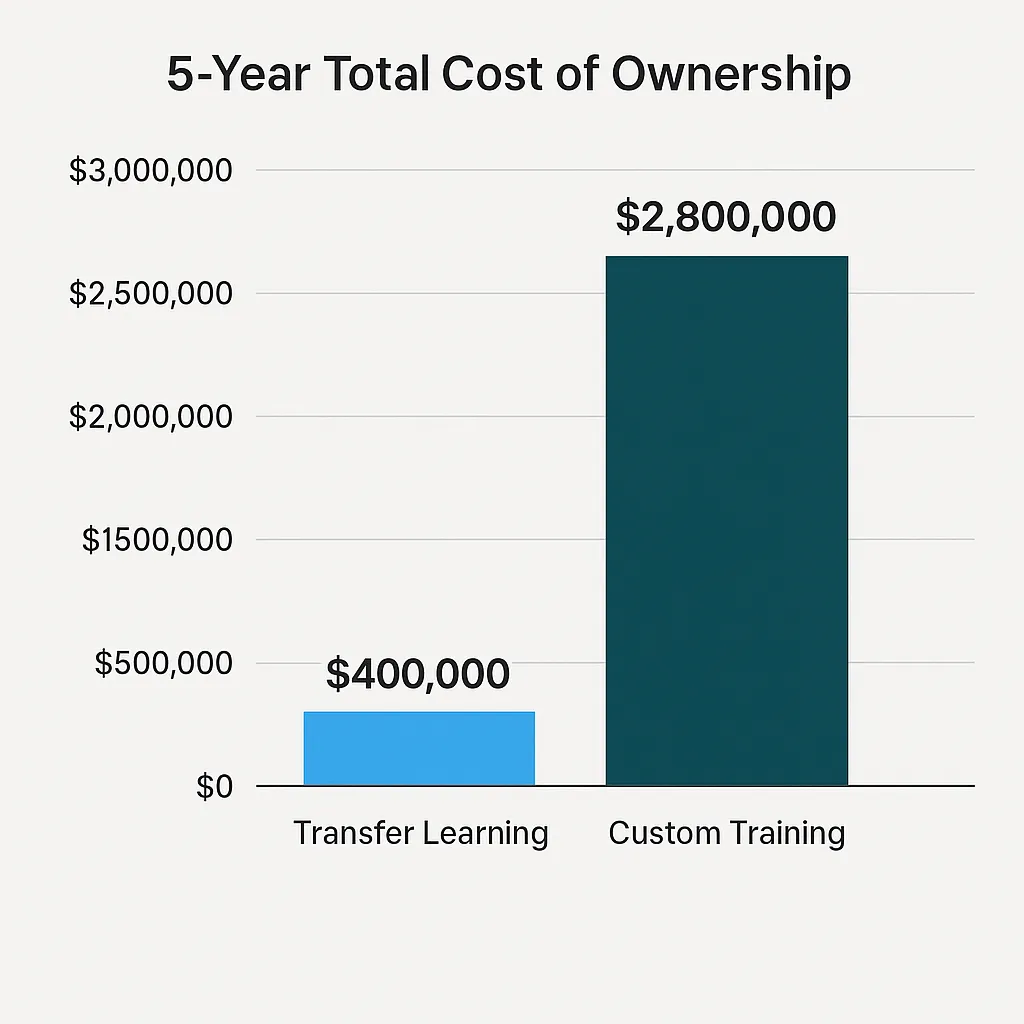Enterprise AI projects fail at alarming rates, and most companies blame budget overruns or technical complexity. But here’s what actually kills most AI initiatives: picking the wrong development approach from day one.
You’re facing a critical choice that will determine whether your AI project delivers results in weeks or burns through millions over months. Transfer learning can slash costs while cutting development time from years to weeks. Training from scratch offers maximum control but demands massive budgets and specialized talent most companies simply don’t have.
This analysis breaks down the real costs, performance trade-offs, and strategic implications of both approaches. You’ll get specific numbers, implementation timelines, and a decision framework based on actual enterprise deployments—not theoretical comparisons.
Over 300 global clients have made this exact decision, and the data reveals clear patterns about which approach delivers better ROI for different business scenarios.
Transfer Learning Wins on Cost and Speed, Custom Training Wins on Control
Transfer learning reduces enterprise AI costs dramatically and cuts development time from months to weeks, achieving 85-95% of custom model performance.
Training from scratch requires budgets exceeding $500,000 and 18+ month timelines but delivers maximum customization for specialized domains.
Why Most AI Projects Fail: It’s All About The Foundation
Gartner predicts 85% of AI projects will deliver erroneous outcomes due to bias, data issues, or management problems. But before you even worry about bias, you need to survive the development phase.
Transfer learning versus custom training represents the single most important strategic decision in enterprise AI development. This choice determines your timeline, budget requirements, and success probability before you write a single line of code.
McKinsey reports that less than one-third of AI projects reach full deployment, often because companies underestimate the complexity and cost differences between development approaches.
A 2024 banking client switched from custom development to transfer learning and launched an AI-powered underwriting tool in 6 weeks—compared to their prior custom build that failed after 12 months and $1.1M invested.

Fig1. AI Project Success Rates – Transfer Learning vs Custom Training
Transfer learning delivers optimal ROI for enterprises with limited budgets, tight timelines, or standard use cases like document processing and customer service. Training from scratch becomes cost-effective only when proprietary data advantages justify massive additional investment.
Transfer Learning: Fast, Cheap, and Surprisingly Effective
Transfer learning works by taking pre-trained models like GPT, BERT, or ResNet as starting points, then fine-tuning them on your enterprise-specific data. This approach reduces computational costs by 80-90% because you avoid the expensive pre-training phase that can cost millions in GPU hours.
Data Requirements Drop Dramatically
Academic research shows transfer learning can reduce required training data by 80-90%—from millions to thousands of examples. This matters because data collection and labeling represents 40-60% of most AI project budgets.
Teams need 75% fewer specialized AI engineers, reducing personnel costs and hiring complexity significantly. Transfer learning relies on standard ML engineering skills available in most technology markets.
Real-World Performance Numbers
SmartDev’s VERA AI Agent, winner of the 2024 Sao Khue award, used transfer learning for customer service automation. The project delivered in 7 weeks with 92% accuracy at 65% lower cost versus custom development estimates.
Key Transfer Learning Benefits:
- Development time: 4-8 weeks typical
- Cost reduction: 60-80% versus custom training
- Data requirements: 90% less than training from scratch
- Accuracy: 85-95% of custom model performance
- Team size: Standard ML engineers (not AI specialists)

Fig2. Transfer Learning vs Custom Training – Side-by-Side Comparison
Most enterprise use cases see no meaningful performance degradation when using properly fine-tuned foundation models. Transfer learning model deployment cycles are significantly faster than scratch-built alternatives.
Custom Training from Scratch: When Control Justifies the Cost
Building custom AI models from scratch requires collecting 10-100x more data than transfer learning, often necessitating expensive data acquisition partnerships. Development teams need rare specialists in model architecture, distributed training, and optimization.
The True Cost of Going Custom
Forbes reports enterprise AI implementation costs can easily exceed $1M for custom solutions when you factor in infrastructure, talent, and extended timelines. Deloitte’s enterprise AI benchmarking confirms these cost ranges are typical for large-scale custom implementations.
When Custom Training Makes Sense:
- Highly regulated industries requiring complete model transparency
- Unique data advantages that create competitive moats
- Specialized domains where foundation models don’t exist
- Hardware-specific optimization requirements
- Proprietary architecture needs
A global manufacturer spent $1.6M (2023-2024) on a custom AI vision solution for defect detection, achieving 12% higher accuracy than generic models but facing 14 months to deploy.
Performance vs. Investment Trade-offs
Academic benchmarking shows custom development yields 5-15% higher performance in specialized domains but costs 5-10x more with significantly lower success odds. Complete architectural control enables optimization for specific hardware constraints, latency requirements, or integration needs that foundation models can’t address.
However, 60% of enterprises cite insufficient technical capability as the main blocker to custom AI development. The specialized talent required commands $200,000+ annual salaries and often takes months to find.
Real Cost Breakdown: What You’ll Actually Pay
Let’s break down the real investment requirements for both approaches, including the hidden costs that catch most enterprises off guard.
Transfer Learning Investment
According to SmartDev’s AI development cost analysis:
- Up-front development: $50,000-$200,000
- Monthly operations: $5,000-$20,000
- First-year total: $100,000-$400,000
Custom Training Investment
Based on industry benchmarking data:
- Up-front development: $500,000-$2M+
- Infrastructure alone: $100,000-$500,000
- First-year total: Typically exceeds $1M
- Timeline: 18-month development cycles are standard
A fintech client’s transfer learning NLP rollout cost $180,000 for initial launch plus $18,000 monthly for maintenance. Their previous custom model attempt in the same sector cost $1.5M and took 16 months before being abandoned.
Hidden Cost Factors:
- Data preparation: 40-60% of project costs (both approaches)
- Regulatory compliance: $50,000-$200,000 additional in regulated industries
- Change management: Often doubles technical implementation costs
- Ongoing maintenance: Can exceed initial development investment

Fig.3 5-Year Total Cost of Ownership
Ready to cut your AI development costs by up to 60%?
Discover how transfer learning can dramatically reduce training time, compute expenses, and data-labeling costs compared to building models from scratch.
Compare both approaches side-by-side, understand real enterprise cost drivers, and choose the strategy that delivers a faster ROI for your AI initiatives.
Explore the Cost BreakdownPerformance Reality Check: When “Good Enough” Beats “Perfect”
Performance comparisons between transfer learning and custom models reveal nuanced trade-offs that go beyond simple accuracy metrics.
Accuracy Isn’t Everything
MIT Sloan research on AI ROI shows that most enterprise applications benefit more from faster deployment than marginal accuracy improvements. Transfer learning models achieve 85-95% task accuracy within 4-8 weeks of development start.
Custom models can reach 90-98% accuracy but require 6-12 months of optimization and testing. The marginal accuracy improvement rarely justifies 5-10x cost increases for most business applications.
Speed Matters More Than Perfection
The VeryPay payments platform used transfer learning for KYC automation, achieving 93% accuracy and deployment in 5 weeks. This enabled mobile operators to double onboarding completions—a business impact that outweighed any theoretical accuracy gains from custom development.
Performance Comparison Summary:
- Transfer learning: 85-95% accuracy, 4-8 week deployment
- Custom training: 90-98% accuracy, 6-12 month deployment
- Business impact: Speed often trumps marginal accuracy gains
Transfer learning benefits from continuous improvements to foundation models, providing automatic capability upgrades. Custom models require dedicated teams for ongoing optimization, security patches, and capability enhancements.
Decision Framework: Choose Based on Your Situation, Not Industry Hype
Your choice between transfer learning and custom development should align with financial readiness, technical capabilities, and strategic value requirements.
When Transfer Learning Wins
Choose transfer learning if you have:
- AI budgets under $500,000
- Timeline pressure (need results in 6 months or less)
- Standard use cases (NLP, computer vision, forecasting)
- Limited AI engineering talent
- Need for rapid iteration and improvement
When Custom Training Makes Sense
Choose custom development if you have:
- Multi-year AI investments exceeding $1M
- Highly specialized domain requirements
- Proprietary data that creates competitive advantage
- Regulatory requirements for complete model transparency
- Existing team of AI specialists
Hybrid Approach for Complex Organizations
A healthcare client initially targeted custom model development, then shifted to transfer learning after budget reassessment. They deployed their solution in 7 weeks at 80% lower cost while still meeting regulatory requirements through careful model documentation and validation.
Many enterprises find success with hybrid approaches—using transfer learning for rapid prototyping and proof-of-concept, then selectively investing in custom development for core differentiating capabilities.
Implementation Roadmap: Execute Your Chosen Strategy
Successful implementation depends on realistic planning, proper resource allocation, and clear success metrics regardless of your chosen approach.
Transfer Learning Implementation Timeline
Weeks 1-2: Data Audit and Preparation
- Comprehensive data quality assessment
- Identify and clean relevant datasets
- Map data to target model requirements
Weeks 3-4: Model Selection and Initial Fine-tuning
- Select appropriate foundation models
- Begin fine-tuning with enterprise data
- Establish validation metrics
Weeks 5-8: Deployment and Validation
- Deploy pilot implementations
- Measure performance against business metrics
- Plan scaling based on results
Custom Development Implementation Timeline
Months 1-3: Feasibility and Architecture Planning
- Extensive feasibility analysis
- Architecture design and validation
- Team assembly and infrastructure setup
Months 4-12: Model Development and Training
- Data collection and preparation (ongoing)
- Model architecture implementation
- Distributed training and optimization
Months 13-18: Validation and Deployment
- Comprehensive testing and validation
- Performance optimization
- Production deployment and monitoring
Risk Mitigation for Both Approaches
Essential Risk Management Steps:
- Establish clear success metrics and exit criteria upfront
- Implement comprehensive testing including bias detection
- Plan for ongoing model governance and compliance
- Budget for change management and user training
- Create fallback plans for performance issues
SmartDev’s AI-powered document processing for a logistics firm demonstrates effective risk mitigation—they launched an MVP in 6 weeks with full rollout in 90 days, compared to a previous scratch project that took 13 months and failed to deliver required accuracy.
The Bottom Line: Transfer Learning Wins for Most Enterprises
For most enterprises, transfer learning provides the optimal balance of performance, cost, and implementation speed. The technology has matured to the point where foundation models handle 90%+ of common business use cases effectively.
Custom development should be reserved for scenarios where proprietary advantages justify the significant additional investment and complexity. Even then, consider starting with transfer learning to validate assumptions before committing to full custom development.
My recommendation: Start with transfer learning for your first AI implementation. Learn what works in your organization, then selectively invest in custom development for truly differentiating capabilities.
Ready to implement AI that actually delivers results? SmartDev’s AI development services help enterprises choose the right approach and execute successful deployments. Our AI consulting team has guided over 300 global clients through these critical decisions, delivering measurable ROI and competitive advantage.
Contact SmartDev to discuss your enterprise AI strategy and get started with the right approach for your specific needs.








